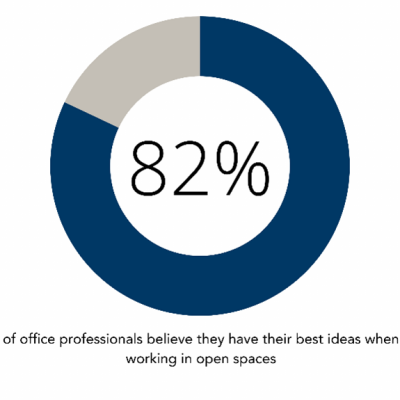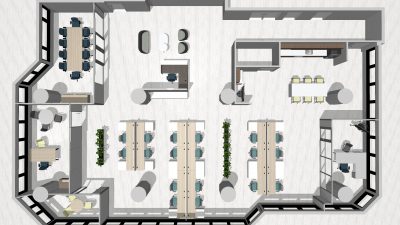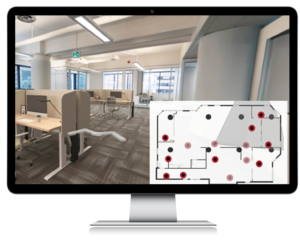With COVID-19 changing the workforce landscape, the meaning of employee engagement and productivity has been redefined for many organizations. The role of the office space in the business-continuity plan must evolve simultaneously. Across industries, studies show that organizations will continue to value the physical workspace as a tool that fosters good social connection, strengthens culture, and develops talent. For employers looking to transform the office space post-pandemic, strategies such as reallocating space, improving spatial legibility, and redefining the ratio of permanent to flexible workspaces can help ensure the office space evolves to meet the needs of the post-pandemic workforce.
Reallocating Space in the Post-Pandemic Office
Creating open workspaces is one way that employers can transform the office space for the return to work. The Leesman Index for Workplace Effectiveness (2018) found that 82 percent of professionals believe they have their best ideas when working in open spaces. Organizations can create open workspaces by reallocating space in the office design to give way to flexible workstations and collaborative solutions.
Improving Spatial Legibility
Open spaces that have good spatial legibility are ones that are well-organized and easy to “read”. Good lighting and easy-to-move objects and furnishings are ways that employers can give the illusion of added space in the post-pandemic office, without physically demarcating it.

Post-Pandemic Desk Occupancy
Across industries, studies show that organizations do not expect to see their entire workforce return to the office space post-pandemic, with 82 percent of employers surveyed by Gartner expecting to adopt some form of distributed work strategy. To transform the office space into a collaborative tool, employers can offer more flexible workstations – changing the ratio of flexible to permanent desk options in the space.


Visual B: Traditional design, featuring 20 permanent workstations and 5 flexible workstations.
The post-pandemic office design for 81 Metcalfe, Suite 200, offers more flexible, open workspaces than permanent desks in the space, compared to the traditional layout featuring a greater number of permanent workstations and only a handful of flexible solutions. While the size of the suite, measuring at 4200 sq.ft., remains unchanged, by redefining the permanent to flexible desk occupancy ratio, improving spatial legibility, and reallocating space, employers can offer an open, collaborative workspace to professionals returning to work. To step into the post-pandemic office at Suite 200, take the virtual tour.
Visit the listing page for 81 Metcalfe for more information about this property.
Read Part 1 – The Post-Pandemic Office: Transforming the Office Space for the Return to Work
Read Part 2 – The Post-Pandemic Office: Creating Positive Workspaces Using Mood-Boosting Elements
Read Part 3 – The Post-Pandemic Office: Designing Collaborative Spaces that Perform



